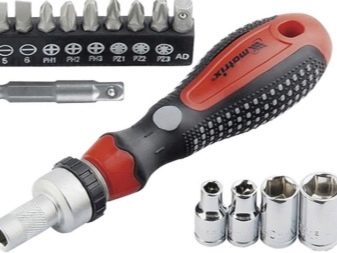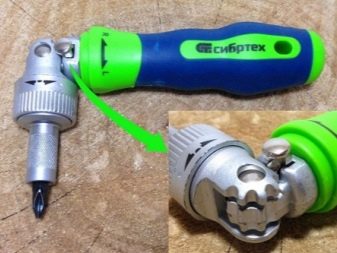All About Reversible Screwdrivers

Reversible screwdrivers were invented relatively recently and immediately gained popularity among craftsmen. Stable demand and high appraisal of professionals are due to ease of use, versatility and reasonable price.
Device and principle of operation
A reversible screwdriver is a tool consisting of a handle equipped with a rubber anti-slip coating, a switch that allows the tool to work in three modes, and a metal rod with a built-in ratchet mechanism.

Most of the models are already equipped with a set of bits that have different configurations and are designed for twisting / unscrewing hardware of various sizes and shapes. The material for manufacturing the working parts of the screwdriver and bit is a chromium-vanadium alloy, the strength of which on the Rockwell scale reaches 45-50 units.
The principle of operation of a screwdriver is quite simple and consists in the following: a special "pawl" is pressed against the cogwheel by means of a spring and does not allow it to rotate in the opposite direction. Because of the characteristic sound, this mechanism is called a ratchet. The direction of rotation of the bit is adjusted using a switch that can be set in three positions: for twisting, unscrewing and blocking. By their design, switches are divided into ring switches that can rotate around the longitudinal axis, flag switches equipped with a small lever, and slide switches equipped with a key.


In the “twisting” position, the direction of the working stroke is clockwise, and when you try to turn the tool in the opposite direction, the ratchet comes into action and switches the tool stroke to idle. The screwdriver handle can rotate freely in the opposite direction, while the bit is securely fixed in a certain position. When the switch is in "twisting" mode, everything is the same, only with the restriction of the movement of the tip clockwise. In the "lock" position, the reversible tool turns into a conventional screwdriver and any of the specified directions of movement will be working.


Purpose
The scope of application of reversible ratchet screwdrivers is quite wide. They are used for construction work and furniture assembly, for repairing cars, bicycles and motorcycles, as well as when working with electronic equipment and household items that have threaded connections. The tool has proven itself well for unscrewing oxidized, rusted and stuck fasteners, for control screwing of hardware, as well as when working in hard-to-reach places where it is impossible to tighten a screw with a classic screwdriver.

For such cases, flexible, T-shaped or angular models are used, which are available on the market in a large assortment. The presence of special nozzles in the kit makes it possible to work with bolted connections and socket heads, which significantly expands the area of use of the tool and allows you to replace the wrench with it. Thanks to the ratchet, work with a screwdriver can be performed with one hand without interception. This is especially valuable when it becomes necessary to hold the element to be screwed in with the other hand.

Advantages and disadvantages
The popularity of reversible screwdrivers due to a number of indisputable advantages of this instrument over classical models.
- The ability to work without removing the tip from the slot of the hardware allows you to do the job much faster and more efficiently.
- All manipulations with the screwdriver can be performed with one hand without interception. This puts less strain on the hand and does not cause fatigue.
- The accessory case that comes with most models is divided into many compartments, where each bit, head, nozzle and extension cord has its own place. This is very convenient and, if necessary, allows you to quickly find the desired element.
- Thanks to the wide variety of attachments, the ratchet screwdriver can replace a whole set of locksmith tools.


- All reversible screwdrivers are fully compatible with commercially available bits, heads and other accessories, which allows you to purchase the necessary bits if necessary.
- The handle of the tool is made of water and dirt-repellent material with dielectric properties. This makes it possible to work with live hardware. In addition, the handle is resistant to chemicals and acids, which makes it possible to use it in many aggressive environments. However, with prolonged contact with gasoline or thinner, the rubber layer may begin to deteriorate.
Along with a large number of obvious advantages, the tool still has its disadvantages. These include quick ratchet failure and poor resistance to drops and impacts. When the hardware is frozen, you cannot hit such a tool, since the mechanism may simply break.

Varieties
The classification of reversible screwdrivers is made by design type and has four types of devices.
- Rotary models made in the form of a handle connected to the head by means of a hinge. Such screwdrivers are indispensable when working in places with limited access and are able to change the angle of inclination of the handle relative to the axis of the working tool.
- Pistol screwdrivers have a L- or T-shaped structure and act as a lever. Thanks to this design, much less effort is spent on unscrewing the hardware, and the comfortable ergonomic shape eliminates excessive brush stress. Pistol models are indispensable for repairing vehicles and other mechanisms that require considerable force to be disassembled.


Screwdrivers of this type are usually equipped with an extension cord designed to work in confined spaces, a set of bits of different standard sizes, cap heads up to 13 mm in diameter and adapters for them.
- Lever models have a universal design in which the handle can be bent relative to the working tool at an angle of up to 90 degrees. This allows you to turn a traditional screwdriver into an L-shaped screwdriver with one movement of your hand. It is convenient to use such models when ripping off sticky hardware from the place, as well as for control pulling of any threaded connections.
- Special models for precision work are equipped with a set of small bits and are used to repair watches, electronic devices and other mechanisms that use small fasteners. The tool is often equipped with extension cords, without which modern electronic devices cannot be disassembled.


Criterias of choice
When buying a reversible screwdriver, you should pay attention to such important technical parameters as the material of manufacture of the tool, the strength of the rod and the basic configuration. So, the optimal value of the strength of the rod is in the range of 47–52 units. The same requirements apply to the strength of bits and sockets that come into direct contact with fastening hardware.As for the metal from which the working parts of the tool are made, it is better to choose a chromium-vanadium alloy, which has high mechanical strength and can withstand significant loads. The basic equipment is also an important selection criterion and depends on the type of work for which the tool is purchased.
For home use, a standard set of flat and cross bits is usually sufficient, while for professional activities or car repairs, you will need to additionally purchase a set of cap heads, which should include six- and twelve-sided models, as well as the SuperLock (SL) modification, which has an increased contact area with the hardware. The last head is designed specifically for unscrewing the torn edges of the fastener head. In addition, it is necessary to purchase an adapter for the cap heads, which acts as an adapter that secures the head to the tool. By their design, adapters are monolithic and hinged, so if you intend to unscrew the hardware at an angle, then it is better to choose the latter.

Manufacturers overview
Rating of companies producing reversible screwdrivers, as follows:
- German company Wera;
- American Stanley;
- Swedish Bahco;
- firms Wiha, Felo and Gross, also from Germany.
Of the Russian brands, the products of the companies "Enkor" and "Zubr" proved to be quite good, the products of which are in no way inferior to eminent foreign counterparts.






In the next video, you will find an overview of the Haupa and Bosch reversible screwdrivers.













The comment was sent successfully.